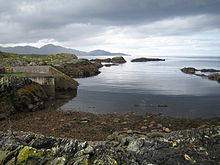Ballycrovane
The Oghamstein of Ballycrovane ( Irish Béal an Churraigh Bháin also called Faunkill or Faunkil-and-the-Woods) stands at Eyeries on the Beara Peninsula in the southwest of County Cork on the Irish island. The Ogham stone stands on a small hill in a bay of Coulagh Bay, is needle-shaped and slim and with a height of 5.3 m the highest Ogham stone ever. It is an Irish national monument .
Irish scientists believe that the stone was erected in the end of the Bronze Age between 800 and 700 BC. Dated. The Ogham inscription, which is located in the upper half on a corner of the stone, is probably a millennium younger than the construction of the stone, which was initially an unlabeled menhir .
The inscription reads: MAQI - DECCEDDAS TURANIAS, which translates as "from the son of the dike, descendant of Torainn". The two are not historically transmitted characters and the translation is controversial.
The meaning of the menhirs and the ogham stones is unclear. Some mark burial sites, others are interpreted as markings along prehistoric routes. Some speculate that the stone may have been erected as a territorial marker.
Trivia
The location was the setting for the filming of the film "The Purple Taxi" (1977) starring Fred Astaire , Peter Ustinov and Charlotte Rampling . The 1998 TV series “Falling for a Dancer”, a dramatization of life and love in Ireland around 1930, based on the novel by Deirdre Purcell , was also shot near the Ballycrovane Stone.
literature
- Peter Harbison : Guide to the Naional Monuments in the Republic of Ireland Gill and Macmillan, Dublin 1992 ISBN 0-7171-1956-4 p. 50
Web links
Coordinates: 51 ° 42 ′ 46.8 ″ N , 9 ° 56 ′ 39 ″ W.

